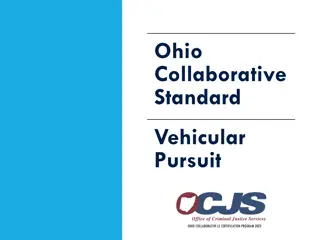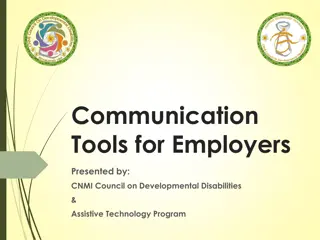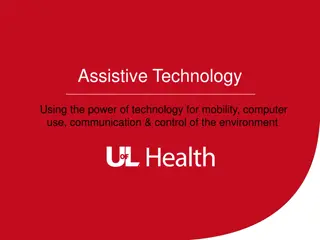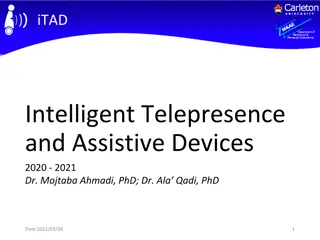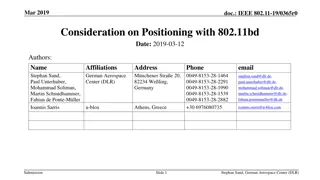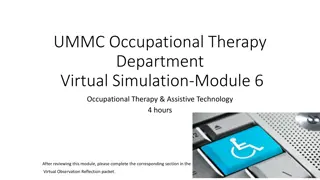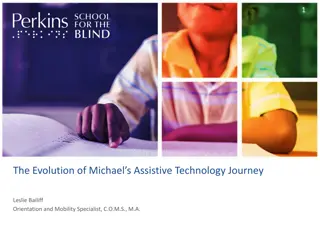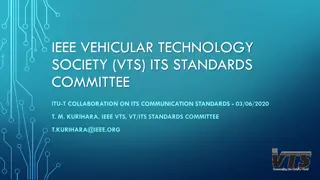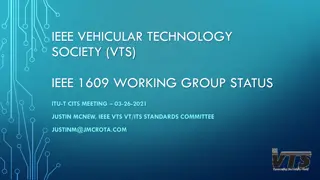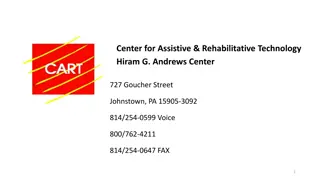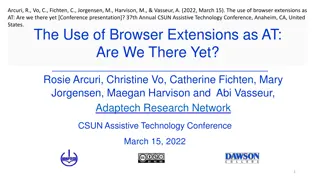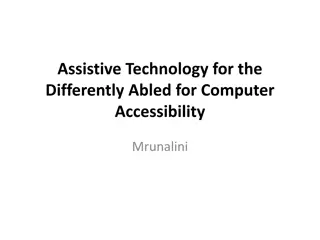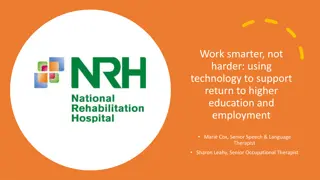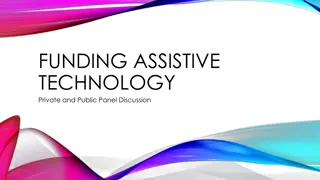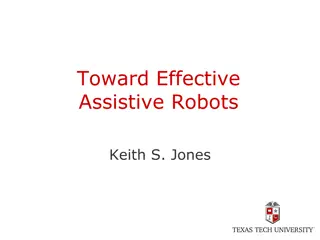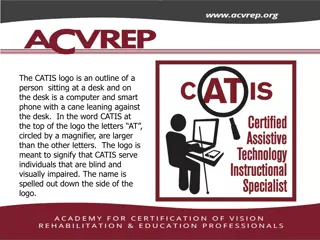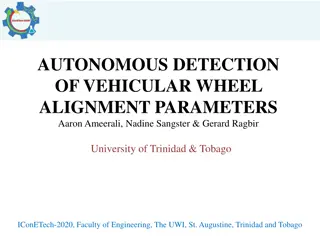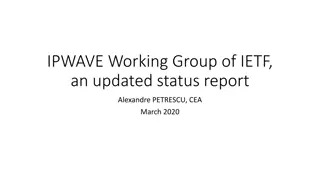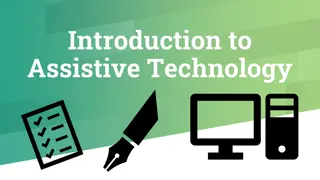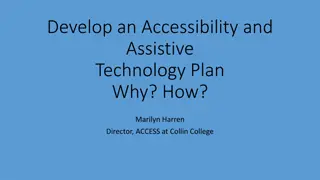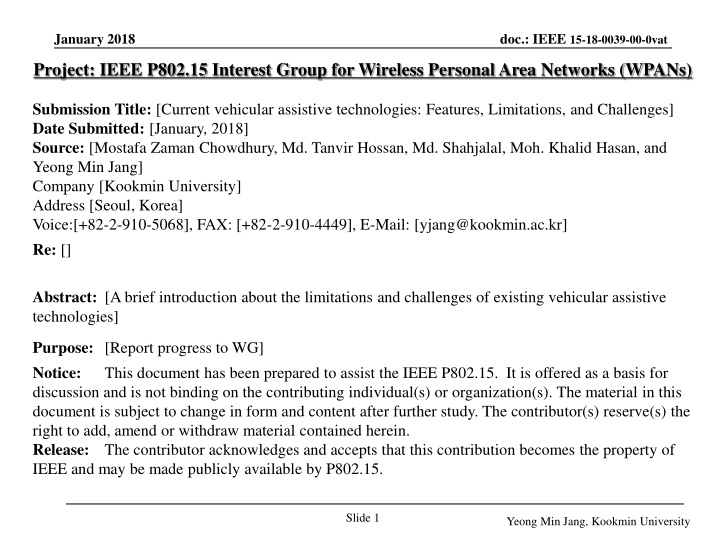
Vehicular Assistive Technologies: Features, Limitations & Challenges
Explore the features, limitations, and challenges of current vehicular assistive technologies in this insightful document, which discusses various technologies and protocols used or proposed for vehicle assist issues, including Optical Camera Communication (OCC).
Download Presentation

Please find below an Image/Link to download the presentation.
The content on the website is provided AS IS for your information and personal use only. It may not be sold, licensed, or shared on other websites without obtaining consent from the author. If you encounter any issues during the download, it is possible that the publisher has removed the file from their server.
You are allowed to download the files provided on this website for personal or commercial use, subject to the condition that they are used lawfully. All files are the property of their respective owners.
The content on the website is provided AS IS for your information and personal use only. It may not be sold, licensed, or shared on other websites without obtaining consent from the author.
E N D
Presentation Transcript
January 2018 doc.: IEEE 15-18-0039-00-0vat Project: IEEE P802.15 Interest Group for Wireless Personal Area Networks (WPANs) Submission Title: [Current vehicular assistive technologies: Features, Limitations, and Challenges] Date Submitted: [January, 2018] Source: [Mostafa Zaman Chowdhury, Md. Tanvir Hossan, Md. Shahjalal, Moh. Khalid Hasan, and Yeong Min Jang] Company [Kookmin University] Address [Seoul, Korea] Voice:[+82-2-910-5068], FAX: [+82-2-910-4449], E-Mail: [yjang@kookmin.ac.kr] Re: [] Abstract: [A brief introduction about the limitations and challenges of existing vehicular assistive technologies] Purpose: [Report progress to WG] Notice: This document has been prepared to assist the IEEE P802.15. It is offered as a basis for discussion and is not binding on the contributing individual(s) or organization(s). The material in this document is subject to change in form and content after further study. The contributor(s) reserve(s) the right to add, amend or withdraw material contained herein. Release: The contributor acknowledges and accepts that this contribution becomes the property of IEEE and may be made publicly available by P802.15. Slide 1 Yeong Min Jang, Kookmin University
January 2018 doc.: IEEE 15-18-0039-00-0vat IEEE 802.15 IG VAT Current Vehicular Assistive Technologies: Features, Limitations, and Challenges Slide 2 Yeong Min Jang, Kookmin University
doc.: IEEE 15-18-0039-00-0vat Introduction January 2018 Currently, there are various technologies and protocols are either used and proposed for vehicle assist issues. Those technologies has some advantages along with some drawbacks individually. In this document, we discuss about those features and limitations of those technologies. Concurrently, the existing challenges in the development progress of them also discuss at the end of the document. Optical camera communication (OCC) is able to overcome the existing limitations. Slide 3 Yeong Min Jang, Kookmin University
doc.: IEEE 15-18-0039-00-0vat January 2018 Features of Vehicular Assistive Technology The technology use wireless channel with massive connected nodes. Delivering information from one vehicle to another vehicle to make fast decision. The encoding and modulation scheme must applicable in all speed scenarios (e.g., 110 km/h) The technology should be cost effective and modify little bit the whole infrastructure for vehicle environment. The position node as well as the network topology will change frequently due to varying speed of vehicles. All supporting infrastructures will inter-connect with each other and simultaneously assist the vehicle during the demand. Slide 4 Yeong Min Jang, Kookmin University
doc.: IEEE 15-18-0039-00-0vat January 2018 Limitations of Vehicular Assistive Technology (1/2) On the basis of MAC protocol Protocol IEEE 802.11p ADHOC MAC VC-MAC MP-MAC DMAC Limitations Quality-of-service is deteriorate in real traffic scenarios. Fixed slot number. Communication between certain nodes is limited. Multi-hop communication is impossible. It is failing without the information about geographic position. Slide 5 Yeong Min Jang, Kookmin University
doc.: IEEE 15-18-0039-00-0vat January 2018 Limitations of Vehicular Assistive Technology (2/2) On the basis of routing protocol Routing protocol Connectivity-aware routing Instant messaging services Caching geocast Urban multi-hop broadcast protocol Inter-vehicle geocast Greedy perimeter stateless routing Limitations Depends on previous data and average velocity of vehicle. The maximum distance between host vehicle and other vehicle has an impact of making instant decisions. Network partition has an affect on it. Performance is deteriorate during less traffic scenario. Depending on Global Positioning System (GPS). It is a direct communication protocol. Slide 6 Yeong Min Jang, Kookmin University
doc.: IEEE 15-18-0039-00-0vat January 2018 Challenges in Vehicular Assistive Technology Challenges: There are several obstacle that is in front of autonomous vehicle authentication processes. Moreover, this is delayed due to numerous reason; privacy is important among them. This type of network should be fully available for real-time applications. Without the precise solution, it will bring serious damage rather than current conditions. It s performance will be constant in any speed of the vehicles especially high speed. It may mitigate the interference from other similar technologies. Slide 7 Yeong Min Jang, Kookmin University
doc.: IEEE 15-18-0039-00-0vat Conclusion January 2018 Discusses about the features of vehicular assistive technologies with considering high speed scenarios. Stating their limitations in the point of MAC and routing protocols. Describe the key challenges for implementing vehicular assistant technology for the same high speed scenarios of the vehicle. Deployment of OCC is able to overcome the existing limitations. Slide 8 Yeong Min Jang, Kookmin University

